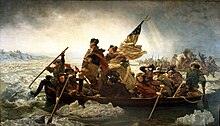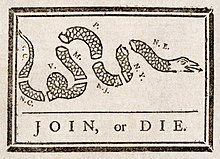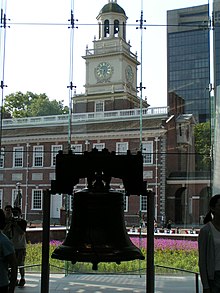
The Battle of Brandywine, also known as the Battle of Brandywine Creek, was fought between the American Continental Army of General George Washington and the British Army of General Sir William Howe on September 11, 1777, as part of the American Revolutionary War (1775–1783). The forces met near Chadds Ford, Pennsylvania. More troops fought at Brandywine than at any other battle of the American Revolution. It was also the second longest single-day battle of the war, after the Battle of Monmouth, with continuous fighting for 11 hours.

The Continental Army was the army of the United Colonies representing the Thirteen Colonies and later the United States during the American Revolutionary War. It was formed on June 14, 1775 by a resolution passed by the Second Continental Congress, meeting in Philadelphia after the war's outbreak. The Continental Army was created to coordinate military efforts of the colonies in the war against the British, who sought to maintain control over the American colonies. General George Washington was appointed commander-in-chief of the Continental Army and maintained this position throughout the war.
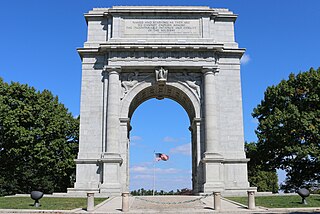
Valley Forge National Historical Park is the site of the third winter encampment of the Continental Army during the American Revolutionary War from December 19, 1777 to June 19, 1778. The National Park Service preserves the site and interprets the history of the Valley Forge encampment. The park contains historical buildings, recreated encampment structures, memorials, museums, and recreation facilities.

Joseph Reed was an American lawyer, military officer, politician, and Founding Father of the United States. He served as aide-de-camp to George Washington, as adjutant general of the Continental Army and fought in several key battles during the American Revolutionary War. He is credited with designing the Pine Tree Flag used during the war.
The 6th Pennsylvania Regiment, first known as the 5th Pennsylvania Battalion, was a unit of the United States of America (U.S.) Army, raised December 9, 1775, at Philadelphia, Pennsylvania, for service with the Continental Army. The regiment would see action during the New York Campaign, Battle of Brandywine, Battle of Germantown, Battle of Monmouth, and Green Spring. The regiment was disbanded on January 1, 1783.
The 8th Pennsylvania Regiment or Mackay's Battalion was an American infantry unit that became part of the Continental Army during the American Revolutionary War. Authorized for frontier defense in July 1776, the eight-company unit was originally called Mackay's Battalion after its commander, Colonel Aeneas Mackay. Transferred to the main army in November 1776, the unit was renamed the 8th Pennsylvania Regiment on 1 January 1777. It completed an epic winter march from western Pennsylvania to New Jersey, though Mackay and his second-in-command both died soon afterward. In March 1777 Colonel Daniel Brodhead assumed command. The regiment was engaged at the Battles of Bound Brook, Brandywine, Paoli, and Germantown in 1777. A body of riflemen were detached from the regiment and fought at Saratoga. Assigned to the Western Department in May 1778, the 8th Pennsylvania gained a ninth company before seeing action near Fort Laurens and in the Sullivan Expedition in 1778 and 1779. The regiment consolidated with the 2nd Pennsylvania Regiment in January 1781 and ceased to exist.
The 11th Pennsylvania Regiment or Old Eleventh was authorized on 16 September 1776 for service with the Continental Army. On 25 October, Richard Humpton was named colonel. In December 1776, the regiment was assigned to George Washington's main army and was present at Assunpink Creek and fought at Princeton in January 1777. During the spring, the unit assembled at Philadelphia, Pennsylvania in a strength of eight companies. The soldiers were recruited from Philadelphia and four nearby counties. On 22 May 1777, the regiment became part of the 2nd Pennsylvania Brigade. The 11th was in the thick of the action at Brandywine, Paoli, and Germantown in 1777. It was present at White Marsh and Monmouth. On 1 July 1778, the unit was consolidated with the 10th Pennsylvania Regiment, and the 11th Regiment ceased to exist. Humpton took command of the reorganized unit.

The 6th Maryland Regiment, active from 27 March 1776—January 1, 1783, is most notable for its involvement during the American Revolutionary war of the same years. An infantry type regiment consisting of 728 soldiers, the 6th Maryland was composed of eight companies of volunteers from Prince Georges, Queen Anne's, Fredrick, Cecil, Harford, and Ann Arundel counties in the colony of Maryland
The 2nd North Carolina Regiment was an American infantry unit that was raised for the Continental Army during the American Revolutionary War. In 1776 the regiment helped defend Charleston, South Carolina. Ordered to join George Washington's main army in February 1777, the regiment subsequently fought at Brandywine and Germantown during the Philadelphia Campaign. After most other North Carolina regiments were sent home to recruit, the 1st and 2nd Regiments remained with the main army and fought at Monmouth in June 1778. The regiment was transferred to the Southern Department and was captured by the British army in May 1780 at the Siege of Charleston. Together with the 1st Regiment, the unit was rebuilt and fought capably at Eutaw Springs. The 2nd was furloughed in April 1783 and officially dissolved in November 1783.
The 8th North Carolina Regiment was authorized on November 26, 1776, and assigned to the Southern Department of the Continental Army. The 8th North Carolina Regiment played a crucial role in the Defense of Philadelphia during the Philadelphia campaign. The unit saw action at the Battle of Brandywine, Battle of Germantown and the Battle of Monmouth during the Defense of Philadelphia of the American Revolution. A part of the continental army, the Regiment was commanded by Colonel James Armstrong. The regiment was disbanded on 1 June 1778 at Valley Forge, Pennsylvania.
The 9th North Carolina Regiment was raised, on 16 September 1776, at Halifax, North Carolina for service with the Continental Army. The regiment saw action at the Battle of Brandywine and Battle of Germantown. The regiment was disbanded, on 1 June 1778, at Valley Forge, Pennsylvania.
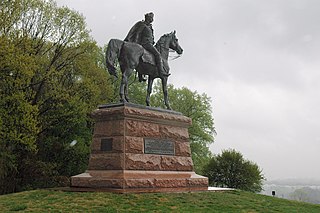
The Philadelphia campaign (1777–1778) was a British military campaign during the American Revolutionary War designed to gain control of Philadelphia, the Revolutionary-era capital where the Second Continental Congress convened and formed the Continental Army and appointed George Washington as its commander in 1775, and authored and unanimously adopted the Declaration of Independence the following year, on July 4, 1776, which formalized and escalated the war.
The Brandywine Battlefield Historic Site is a National Historical Landmark. The historic park is owned and operated by the Pennsylvania Historical and Museum Commission, on 52 acres (210,000 m2), near Chadds Ford, Delaware County, Pennsylvania in the United States.

Valley Forge was the winter encampment of the Continental Army, under the command of George Washington, during the American Revolutionary War. The Valley Forge encampment lasted six months, from December 19, 1777 to June 19, 1778. It was the third and harshest of the eight winter encampments that Washington and the Continental Army endured during the war.
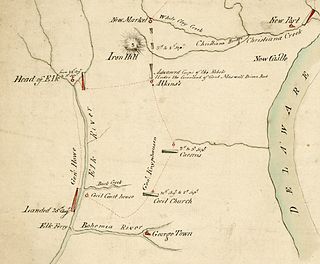
The Battle of Cooch's Bridge, also known as the Battle of Iron Hill, was a battle fought on September 3, 1777, between the Continental Army and American militia and primarily German soldiers serving alongside the British Army during the American Revolutionary War. It was the only significant military action during the war on the soil of Delaware, and it took place about a week before the major Battle of Brandywine. Some traditions claim this as the first battle which saw the U.S. flag.
François-Louis Teissèdre de Fleury was a French nobleman who joined the Royal Army in 1768 and later volunteered to fight in the Continental Army during the American Revolutionary War. In America he demonstrated his bravery at Piscataway in May 1777 after which he was appointed an officer of engineers. He fought at the Brandywine in September and was wounded at Germantown in early October. He served capably during the Siege of Fort Mifflin where he was wounded again in November. George Washington made him an assistant to Friedrich Wilhelm von Steuben at Valley Forge in the spring of 1778. He served during the Monmouth Campaign in June 1778 and fought in Rhode Island in August.

The Museum of the American Revolution, formerly The American Revolution Center, is a museum in Philadelphia, Pennsylvania dedicated to telling the story of the American Revolution. The museum was opened to the public on April 19, 2017, the 242nd anniversary of the Battles of Lexington and Concord, some of the battles of the American Revolutionary War, on April 19, 1775.

Thomas Proctor or Thomas Procter commanded the 4th Continental Artillery Regiment during the American Revolutionary War. He was born in County Longford, Ireland, emigrated to British America, married in 1767 in Philadelphia, Pennsylvania, and joined the carpenter's guild in 1772. Receiving a commission as an artillery captain in October 1775, he proceeded to raise a company of Pennsylvania state artillery. After a second company was recruited, Proctor was promoted to major and both companies joined George Washington's army. Proctor led his gunners at Princeton in January 1777. The state authorities elevated Proctor to the rank of colonel and charged him to recruit an eight-company Pennsylvania State Artillery Regiment a month later.
Hartley's Additional Continental Regiment was an American infantry unit of the Continental Army that served for two years during the American Revolutionary War. The regiment was authorized in January 1777 and Thomas Hartley was appointed its commander. The unit comprised eight companies from Pennsylvania, Maryland, and Delaware. When permanent brigades were formed in May 1777, the regiment was transferred to the 1st Pennsylvania Brigade. Hartley's Regiment fought at Brandywine, Paoli, and Germantown in 1777. The unit helped defend the Pennsylvania frontier against indigenous raids in the Summer and early Fall of 1778. In January 1779, following a resolution of the Continental Congress the regiment, along with Patton's Additional Continental Regiment and part of Malcolm's Additional Continental Regiment, were combined to form a complete battalion known as the "New" 11th Pennsylvania Regiment. The 11th participated in the Sullivan Expedition in the summer of that year. In January 1781 the 11th merged with the 3rd Pennsylvania Regiment and ceased to exist.
Spencer's Additional Continental Regiment, sometimes referred to as the 5th New Jersey Regiment, was an American infantry unit that served for four years in the Continental Army during the American Revolutionary War. The Continental Congress authorized sixteen "Additional" Continental Regiments in late 1776 and Colonel Oliver Spencer accepted command of this regiment with rank from January 15, 1777.
